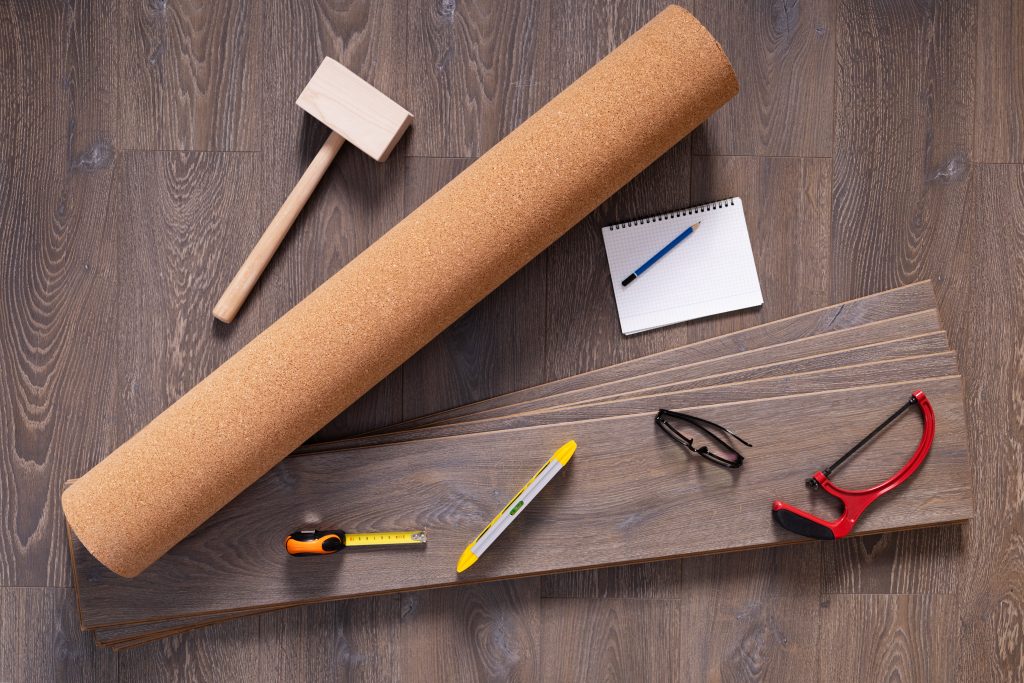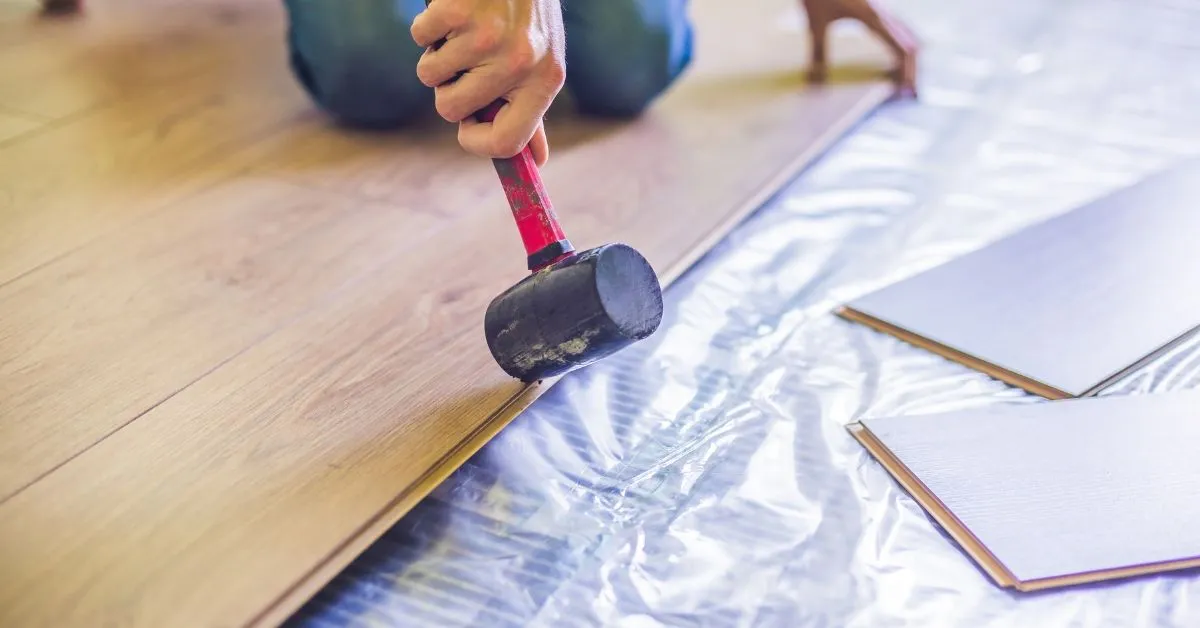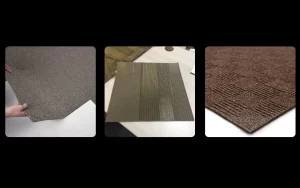What is laminate flooring?
Laminate flooring is a layered floor that is totally made from wood fibers. It is a choice for various settings, like homes, offices, and hospitals. Here’s a detailed overview of laminate flooring: Laminate flooring is made up of 4 layers.
Here are these four layers.
- Wear Layer: The first layer, which is clear and transparent, protects against scratches, stains, and fading.
- Design Layer: This layer gives you stability and endurance because it is composed of the thickest, highest-density fiberboard.
- Core Layer: It is made from thickest and high-density fiberboard, core layer provides you stability and durability.
- Backing Layer: The backing layer, which gives you additional moisture resistance.
Types of Laminate Flooring

There are five types of laminate floors.
1. High-Pressure Laminate:
High pressure laminate is made by multiple layers of craft paper. High pressure laminate is a highly durable material and applicable to interior design such as furniture, wall wrapped pillar. It is known for its resistance to wear and tear. It is great for high-traffic and commercial areas. It is more expensive than other types of laminate.
2. Direct-Pressure Laminate:
Direct pressure is most common type on the market. It is made by pressing the layers of the laminate together without additional reinforcement. It’s Cost-effective and widely available. It is Suitable for residential applications.
3. Premium Laminate Flooring:
Premium laminate is ideal for high traffic area’s. It is manufactured with high quality of material. Premium laminate can give your furniture the premium look of natural material like, metal and wood.
4. Waterproof Laminate:
It is water-resistant laminate. It is ideal for kitchens and bathrooms. Advanced coatings and core materials provides moisture-prone areas.
5. Textured Laminate Flooring:
Textured laminate floor is made of grain and texture of natural wood. It adds depth and realism to your floors and enhances slip resistance.
Benefits of Laminate flooring :
Here are the benefits and advantages of laminate flooring.
1. Affordable: Laminate flooring is budget-friendly and less expensive as compared to hardwood floor or stone.
2. Easy Installation: Many laminate products use a click-lock design that allows for easy installation without the need for any glue or nails.
3. Offer Variety of Styles: Available with a wide range of designs, colors, and textures to decorate your office, home and hospital with a variety of styles from modern to traditional.
4. Durability: The layer protects against scratches, dents, stains and fading, making it suitable for high-traffic areas.
5. Maintenance: It is very Easy to maintain and clean with regular sweeping and damp mopping.
Also check the difference between Vinyl Flooring vs Laminate Flooring.
How Long Do Laminate Floors Last?
Laminate flooring lasts between 15 to 25 years. The lifespan of a laminate floor will surely depend on the product quality of your floor, and how well you maintain and care for it. In some cases, laminate floors can last over 25 years.
How do you maintain Laminate flooring?
1. Regular Cleaning: You can wipe or vacuum regularly to remove extra dirt and debris from the floor. For an extra and deep cleaning, you should use a damp mop with warm water and mild detergent.
2 Avoid bad Chemicals: Must use gentle cleaners, which are specially designed for laminate flooring.
3. Prevent Scratches in the laminate floor: Use furniture pads and avoid heavy items across the floor. Keep your pet’s nails trimmed and remove shoes at the door.
How to Remove Laminate Flooring?
There are many reasons that you may need to remove laminate flooring but with the help of the right tools and a bit of patience. You can also do it by yourself at your place and save your own money. You can easily get rid of the laminate floor, with the help of following these steps.
What Tools Will I Need to Remove My Laminate Flooring?

Before you begin, gather the following tools.
- Pry bar: For lifting planks.
- Hammer: To assist with the pry bar.
- Utility knife: For cutting through any adhesive.
- Tape measure: Use for measuring the width of the room.
- Flathead screwdriver: Used to loosen and tighten screws.
- Work gloves: To protect your Hands.
- Dust mask: To save your face from dust.
- Knee pads: It is used for the protection of against any injury.
- Drill: To create holes.
- Shop Vacuum: Use for the clean purpose.
- Eye Protection: To protect your eyes.
Now that you have the right tools! Many people ask as well, ‘How do I pull up laminate flooring?’
Here’s how you can do it:
How to Pull Up Laminate Flooring
You can pull up your laminate floor through a pry bar. First of all you need to follow these steps to pull up your laminate floor. First thing you need to clear the area and remove all the furniture from the floor to create a clear place. Then use a utility knife to cut the edges, where the baseboards meet the laminate. Then using a crowbar, starting from one end and working your way. Be gentle to avoid damaging the baseboards. Once you have lifted the first plank, then continue removing the adjacent planks. Must be careful about laminate flooring they typically lock together, so you may need to slide the planks apart gently. If a layer is often installed under laminate for cushioning, so carefully peel it up after the laminate is removed. Then dispose of the materials that underlayment according to local waste disposal. After all the laminate is removed, then must clean the subfloor to remove extra dust and debris.
6 steps to removing laminate flooring:
1. Clear the Floor
Before the preparation, you should have to clear the room and remove all the furniture and extra items that will give you space to work and prevent any damage.
2. Remove Baseboards
Use a pry bar or utility knife to carefully remove any baseboards around the perimeter of the room. This step is necessary to prevent any damage to the walls.
3. Identify the Type of Installation
Laminate floors can be installed in various ways, including:
- Floating: The floor is stable without any attachment to the sub-floor.
- Glue-down: This creates a very strong and stable bond.
- Nail-down: Nailing down floors is the most common installation method.
Identifying the type of installation, it will easily guide your removal process.
4. Begin at the Edges
Start at one corner of the room where the planks are not locked with adjacent areas. You have to use a utility knife to lift a section.
For glue-down floors, use the utility knife to cut into the seams and the pry bar to separate the planks from the adhesive. A bit more force may be needed, but be patient to avoid breaking the boards.
For nail-down floors, locate the nails, and using the pry bar and hammer, gently lift the planks and remove the nails.
5. Removing Planks
Work systematically, removing planks row by row. For each plank, pull up or pry away from the edges, maintaining the integrity of the pieces as much as possible.
6. Clean Debris
When all the planks have been removed, any remaining adhesive or nails from the subfloor. Sweep and vacuum them, which is the area you have to prepare for the installation of new flooring.
Safety and Tips
- Always Wear gloves to protect your hands from any sharp things.
- Use a dust mask to avoid inhaling any dust particles.
- Always wear Eye goggles to protect your eyes from debris and dust.
By following these steps, you should be able to remove your laminate flooring effectively and safely! It will make your project manageable, and allow you to move on to your next exciting renovation task.
If you think laminate flooring is outdated. Don’t forget to check our article: Is Laminate Flooring Outdated?
Frequently Asked Questions (FAQs)
Can you install laminate flooring over tiles? [+]
Yes, it is possible. You can easily install laminate floors over tiles without any messy hassle of removing existing tiles.
Is it better to remove tiles before installing laminate flooring? [+]
No, removing tiles before installing a laminate floor is not a good idea. Because, it is costly and time consuming.
How can I cover my floor tiles without removing them? [+]
Yes, there are several ways to cover your floor tile without removing them. You can peel and stick vinyl tiles, carpet tiles, area rugs, cork flooring and rubber flooring on your floor.
Can I lay laminate on top of the tiles? [+]
Yes you can, it is possible to lay laminate directly over them.
Do I need underlayment for laminate flooring over tiles? [+]
Laminate flooring installation over existing tiles is totally your choice. The answer depends on several factors, for even surface, comfort, sound absorption and moisture.








